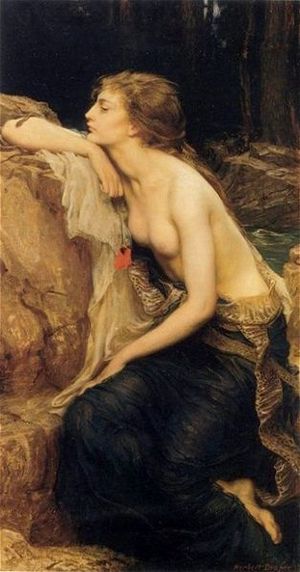Are there vampires in Greek mythology? I guess it all depends on how broad your definition of a vampire is. If you define a vampire strictly as a cadaverous (pun intended), aristocratic man with oversize fangs, a Romanian accent, and dark sexual charisma, who can be warded off with garlic and, should worse come to worst, a stake through the heart, then, no, there are no vampires in Greek mythology. However, if you dare think outside the coffin… eh, the box, then you may recognize prototypical vampire-like demons, ur-vampires, if you will, in ancient Greek myths.
Lamia is probably the best-known Greek precursor to the modern vampire. Lamia was queen of Libya when she had an affair with Zeus, king of the gods. Zeus’ wife, Hera, found out and exacted her revenge on Lamia by killing her children. Lamia’s grief was so devastating, that she transformed into a monster, half-woman and half-snake, that murdered children by drinking their blood. Maybe that had been her destiny all along: The name Lamia derives from the word laimos, which is Greek for “gullet”: Lamia the devourer; Lamia the bloodsucker; Lamia the vampire.
The myth of Lamia became increasingly popular in late antiquity and all through medieval times and the Renaissance. As her sad and macabre tale traveled through the ages, it became engorged, so to speak, with both steamy and gruesome folkloristic elements: wantonness, promiscuity, prostitution, sorcery, shape-shifting, and vampirism. From the story of the original queen Lamia, there sprang a whole group of bloodthirsty witches, the lamiae (or lamiai in Greek). The lamiae fed on human blood and children’s flesh. For centuries, and even to this day, the lamia, a cross between a vampire and a bogey-woman, has been used as a disciplinary horror story by frustrated mothers of misbehaving children. If you have seen the 2006 film “Pan’s Labyrinth” (“El Laberinto del Fauno” directed by Guillermo del Toro), you have actually seen a lamia (well, a male version thereof). The child-gobbling Pale Man shares yet another hideous trait with his Greek predecessor: His eyes do not have to be in their sockets for him to spot his next victim.
In addition to the lamiae, Empusa and Mormo were minor Greek deities with vampiric qualities. Empusa was a shape-shifting seductress, a blood-drinking succubus. Her name is of obscure origin, generally surmised to mean “one-legged” (< *empous < en (one) + pous (foot)). As in the case of Lamia and the lamiae, the myth of the one Empusa spawned a whole demonic species of empusae. Mormo was very similar to Empusa in that she, too, was a ghoulish spirit that drained her victims of their blood. Appropriately enough, Mormo’s name derives from a Greek language root for “fear”. The word mormolykeion, originally meaning “monstrous, scary mask”, came to signify a ghoul, a vampire.
So, how do these mythological prototypes compare to the modern take on vampirism?
Let’s see…
a) Modern vampires are either male or female. Vampires in Greek mythology are exclusively female. (Not gonna go there… not gonna…)
b) Modern vampires are revenants (from the French verb revenir, to come back), i.e. dead people who have come back from the grave. The vampire-like demons of Greek myth are not revenants: They are either mortal women (Lamia) or demigoddesses (Empusa, Mormo) transformed into blood-sucking ghouls.
c) Modern and ancient Greek vampires share the attributes of “the thirst” (i.e. thirst for blood), shape-shifting, supernatural strength, and seductiveness. The ancient Empusa finds her modern equivalent in the psychic vampire, i.e. a vampire who feeds on the life force of the living. (Speaking of psychic vampires, the 1985 cult movie Lifeforce features Mathilda May in the role of a space empusa.)
Centuries after the seminal myths of the lamiae, the mormolyces, and the empusae, a short story called “The Vampyre” (1819) and an epistolary novel called “Dracula” (1897) consolidated the multifarious influences of vampire folklore into one coherent myth.
Any chance the three brides of Count Dracula might have been called Lamia, Empusa, and Mormo?
Sources:
http://en.wikipedia.org/wiki/Greek_mythology
http://www.pantheon.org/areas/mythology/europe/greek/articles.html



